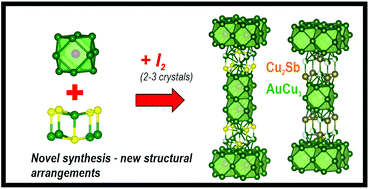Nickel – p-block metal mixed chalcogenides based on AuCu3-type fragments: iodine-assisted synthesis as a way of obtaining new structures†
Abstract
Two new mixed nickel–gallium chalcogenides, Ni9.39Ga2S2 and Ni5.80GaTe2, and a new mixed nickel–indium telluride, Ni5.78InTe2, have been synthesized by a high-temperature ampoule route with the addition of iodine, and characterized from single-crystal or powder diffraction data. They belong to the relatively uncommon Ni7−xMQ2/Ni10−xM2Q2 type of structures (M = Ge, Sn, Sb, In), and are built from p-block metal-centered nickel cuboctahedra, alternating along the c axis with defective Cu2Sb-type nickel–chalcogen ones. Both tellurium-containing compounds show a small degree of orthorhombic distortion with respect to the idealized tetragonal structure, only detectable in the powder diffraction data. No phase transition to the tetragonal structure was detected for Ni5.80GaTe2 by the in situ powder diffraction measurements from room temperature to 550 °C. DFT calculations show close relationships of electronic structures of these ternary compounds to their parent intermetallics, Ni3M (M = Ga, In). Metallic conductivity and paramagnetic properties are predicted for all three with the latter confirmed by magnetic measurements. The bonding patterns, investigated via the ELF topological analysis, show multi-centered nickel – p-block metal bonds in the AuCu3-type fragments and pairwise covalent interactions in the nickel–chalcogen fragments. Both Ni7−xMTe2 compounds showed no structural or compositional changes upon high-temperature mid-pressure hydrogenation.



 Please wait while we load your content...
Please wait while we load your content...